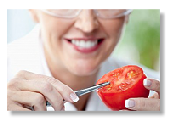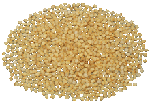CUCUMBER
- Cucumis sativus
- Cucurbitaceae
General information: cucumber appeared 6 thousand years ago. Its motherland is tropical and subtropical regions of India and China, where it still grows naturally (cucumber Hardvika). Fruits of wild-growing cucumber are small and inedible because of containing bitter parts cucurbitacins. In our regions this vegetable became known from 16 century.
Cucumber contains only 4-6 % of dry basis, 2 % of saccharose, 1% of protein substances, 0,7 % of cellulose and 0,1 % of fats. Fruits are not rich in nutrients, calorific value is low (113-148 kkal), but it is valuable for eating and dietary qualities that have tonic agents, encourage protein adoption, enhance digestive secretion. Fresh taste and smell of cucumbers determined by existence of free organic acids and essential oil. Cucumber has a lot of mineral salt, different vitamins, iodine. There is varieties and hybrids of cucumbers for outdoor and undercover growing, mellittophilae and parthenocarpic (fruit formation without insects).
Fresh cucumber has strong diuretic effects and antipyretic action, it can sharply lower acidity of gastric juice. Vegetable fiber almost isn't assimilated in bowel but has important role in action of the bowels as it enforce vermicular movement and clearness of cholesterol. Cucumber puree (100 g on empty stomach) is recommended if you suffer from cramping pain. One ferment was found in cucumber that is close to insulin, so it is valuable dietary product. Fruits also contain ferments that enforce vitamin C formation and vitamin B2 adoption.
In folk medicine cucumber is used for treatment of chalk-stone, lungs and kidney diseases. Cucumber is also used in cosmetic procedures, to have fresh and beautiful face you need fresh cucumber juice.
A little information from botany: - cucumber is annual plant with climbing stem.
- Root system is stalky, the main part of root is in a depth of 15-20 cm and it spreads near the main root in a radius of 1,5 m. Cucumber has ability to form additional root system especially in well-humidity soil in conditions of high atmospheric humidity. Thanks to that fact surface of roots predominate leaves surface in 75-140 times.
- Stalk is in a length of 1,5-2 m. It is brunching, five-cant furrowed and spined. Also there are bunchy and half-bunchy plants in the length of 20 cm, determinate variety and hybrids that stop to grow after 10-12 joints after 40-60 cm in length. Shoots from first and second orders go from the main stalk. Some hybrids have limited develop of side shoots by first order, so branch ends with fruits.
- Petiolate leaves with different degrees of their corrugation, they are a little lobar, five-cant shaped with a smooth or crinkled spined skin (sometimes they are not spined). Leaves situated one by one. Side shoots of first order forms in axil film of leaf. Simple non-branching turbinal cirhus also form in axial film of leaf, thanks to that plant can attach to soil or frame.
- Cucumber has men and female flowers.
- Cucumber is monoecious heteroecious plant that means that one plant has man (staminate) and woman (pistillate) flowers. But sometimes you can meet dioecious plant only with men or women flower, among them there is also andogyne that has men and women organs in one flower. Men flower usually has 5-7 inflorescence of raceme and corymb, women flower has 2-3 inflorescence in axial film of leaf. Cucumber flowers have quinquefid, cupped or scyphoid villouse cup. Rotate flower-crown consists of five petals knitted at the bottom with cup. The colour of flower-crown is bright yellow. Men flower has 5 stamens, four of them are knitted and one is free. Women flower has bottom set and 3-5 lobar snout. Monecious flower has low set and pistil that are surrounded by 6 stamens. It is possible to meet cucumber with partial dioecy with predominate amount of women or men flowers (some varieties from Japan, China and other Eastern countries). Cucumber is cross-pollinating plant. Even monoclinous flower prefers blossom dust from another plant or flower. Self-pollination is very rare. Flowers has short-life, in Northern regions they open in 6-7 o'clock in the morning and after 1-2 days they close. In South regions in hot seasons they can be open just from 4-5 o'clock to midday. Snouts of women flowers more sensitive but men blossom dust has more vitality in first hours after flowers opening, when fertilization takes place. Monoecious plant usually has more man flowers, but in the period of strong branching there are more women flowers. Correlation between flowers can change due to weather conditions or men effect. Decrease of temperature and increase of soil humidity, shorten day in the period of flowers formation, top-dressing with carbon dioxide all these procedures can increase women flowers and of course the yield undercover. If you use open ground growing, the amount of women flowers can be increased by changing acidity (pH). Strong top-dressing with phosphor, potassium, borium and limited amount of azote increase women flower formation. Neutral soil is the best for women flowers formation.
- Cucumber is cross-pollinating plant. Even monoclinous flower prefers blossom dust from another plant or flower. Self- pollination is very rare. Flowers has short-life, in Northern regions they open in 6-7 o'clock in the morning and after 1-2 days they close. In South regions in hot seasons they can be open just from 4-5 o'clock to midday . Snouts of women flowers more sensitive but men blossom dust has more vitality in first hours after flowers opening, when fertilization takes place. Monoecious plant usually has more man flowers, but in the period of strong branching there are more women flowers. Correlation between flowers can change due to weather conditions or men effect. Decrease of temperature and increase of soil humidity, shorten day in the period of flowers formation, top-dressing with carbon dioxide all these procedures can increase women flowers and of course the yield undercover. If you use open ground growing, the amount of women flowers can be increased by changing acidity (pH). Strong top-dressing with phosphor, potassium , borium and limited amount of azote increase women flower formation. Neutral soil is the best for women flowers formation.
- The fruit of cucumber is a false berry with 3-5 seed chambers. Different varieties has different fruit shape, size, colour and other features. One fruit contains from 100 to 400 seeds. But there is also cucumber without seeds, so-called parthenocarpic cucumbers. In industrial ripeness fruit can be from 5 to 70 cm in length, in diameter of 3-5 cm, colour is milky-whitish, and different green tints. In biological ripeness ( with ripened seeds) of different variety has different colour and different crack thickness, from rare cracks to thick racks.
- Cucumber seeds are longish-oval or shorten-eleptical, they are white with yellow tint. The weight of 1000 seeds is from 16 to 35 g. It has excellent storage qualities and keeps viability for 7-8 and even 10 years. Cucumbers can be consumed as fresh, salted or marinade.










